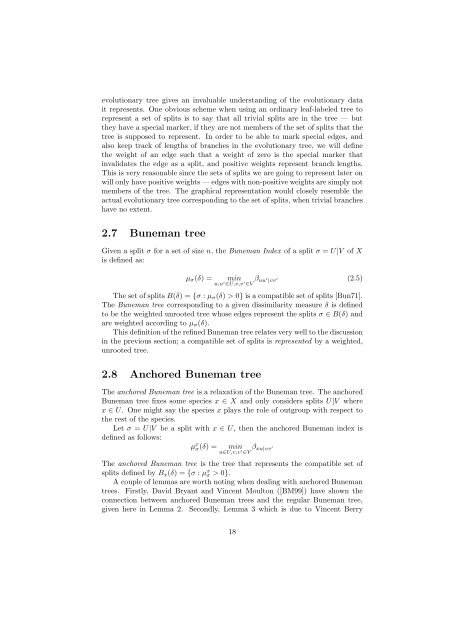Refined Buneman Trees
Refined Buneman Trees
Refined Buneman Trees
Create successful ePaper yourself
Turn your PDF publications into a flip-book with our unique Google optimized e-Paper software.
evolutionary tree gives an invaluable understanding of the evolutionary data<br />
it represents. One obvious scheme when using an ordinary leaf-labeled tree to<br />
represent a set of splits is to say that all trivial splits are in the tree — but<br />
they have a special marker, if they are not members of the set of splits that the<br />
tree is supposed to represent. In order to be able to mark special edges, and<br />
also keep track of lengths of branches in the evolutionary tree, we will define<br />
the weight of an edge such that a weight of zero is the special marker that<br />
invalidates the edge as a split, and positive weights represent branch lengths.<br />
This is very reasonable since the sets of splits we are going to represent later on<br />
will only have positive weights — edges with non-positive weights are simply not<br />
members of the tree. The graphical representation would closely resemble the<br />
actual evolutionary tree corresponding to the set of splits, when trivial branches<br />
have no extent.<br />
2.7 <strong>Buneman</strong> tree<br />
Given a split σ for a set of size n, the<strong>Buneman</strong> Index of a split σ = U|V of X<br />
is defined as:<br />
μ σ (δ) = min β<br />
u,u ′ ∈U,v,v ′ uu<br />
∈V ′ |vv ′ (2.5)<br />
The set of splits B(δ) ={σ : μ σ (δ) > 0} is a compatible set of splits [Bun71].<br />
The <strong>Buneman</strong> tree corresponding to a given dissimilarity measure δ is defined<br />
to be the weighted unrooted tree whose edges represent the splits σ ∈ B(δ) and<br />
are weighted according to μ σ (δ).<br />
This definition of the refined <strong>Buneman</strong> tree relates very well to the discussion<br />
in the previous section; a compatible set of splits is represented by a weighted,<br />
unrooted tree.<br />
2.8 Anchored <strong>Buneman</strong> tree<br />
The anchored <strong>Buneman</strong> tree is a relaxation of the <strong>Buneman</strong> tree. The anchored<br />
<strong>Buneman</strong> tree fixes some species x ∈ X and only considers splits U|V where<br />
x ∈ U. One might say the species x plays the role of outgroup with respect to<br />
the rest of the species.<br />
Let σ = U|V be a split with x ∈ U, then the anchored <strong>Buneman</strong> index is<br />
defined as follows:<br />
μ x σ (δ) = min β u∈U,v,v ′ xu|vv<br />
∈V ′<br />
The anchored <strong>Buneman</strong> tree is the tree that represents the compatible set of<br />
splits defined by B x (δ) ={σ : μ x σ > 0}.<br />
A couple of lemmas are worth noting when dealing with anchored <strong>Buneman</strong><br />
trees. Firstly, David Bryant and Vincent Moulton ([BM99]) have shown the<br />
connection between anchored <strong>Buneman</strong> trees and the regular <strong>Buneman</strong> tree,<br />
given here in Lemma 2. Secondly, Lemma 3 which is due to Vincent Berry<br />
18
















